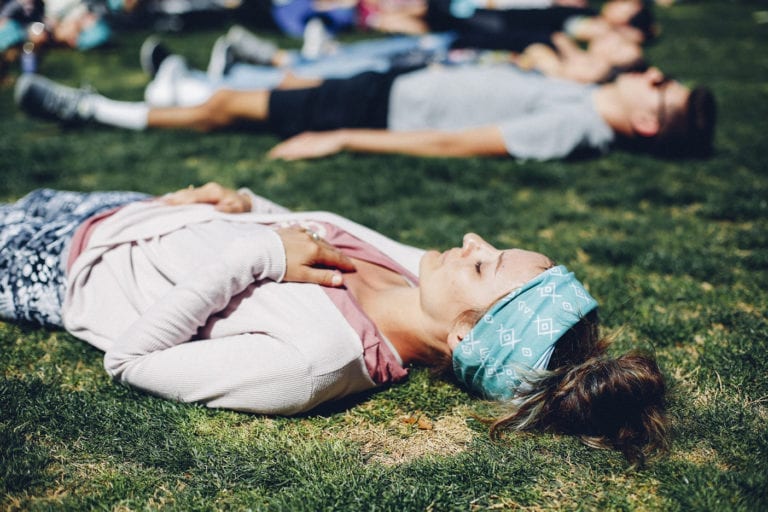
Curious about using breathwork to better your mental health? So were we. To learn more, we teamed up with Salinex and WanderlustTV breathwork teacher Erin Rose Ward about the power of this transformational exercise. Read on for some of Erin’s insider tips and exercises.
Breathing might be the most underrated form of medicine. It’s accessible, completely free, and has the power to alter our physical, mental, and emotional states. We literally cannot live without the breath for longer than a few minutes—so we might as well milk it for all its worth.
While we’re able to focus on the breath in a yoga class, more often than not this essential tool goes unnoticed. But when we pause to pay homage and add intention to this subtle life force, we can deepen our experience of the present moment, gain clarity and mental focus, stoke the immune system, calm anxiety, energize the body, and so much more.
We already have everything we need. All we have to do is pause and breathe. Thirsty to get started? Below are 3 simple breath techniques you can do anytime, anywhere.

1. Visual Breath to Release Stress
This breathwork practice requires no interruption of your daily routine. Do it while commuting, lying in bed, sitting at your desk, waiting in line, or anytime you feel in need of an emotional release. The goal is to use the visualization of your breath as a way to create focus and fuel overall mental and physical balance.
Similar to the technique lauded by the likes of professional athletes and thought leaders, this breath puts trust in the subconscious mind’s ability to reprogram itself out of limiting beliefs. Meaning, if you are feeling stressed, overwhelmed, or triggered emotionally, there may be a deeper belief or pattern that needs addressing. Breathwork helps you clear that air. Your situation may not immediately change after practicing this technique, but your perspective on the scenario could alter in a way that inspires a sense of peace or the courage to mix things up.
How to practice: If you have the space and time, find a comfortable seat and close your eyes. If not, practice right where you are.
Exhale all of your breath out, so much so you feel the belly pull to the spine and no more breath is left in your body. Follow that with a deep breath in through the nose. As you inhale, imagine the breath colored with a white bright light. Once you find your maximum capacity of breath, pause briefly.
Exhale out of the mouth and imagine the exhale is colored with thick black smoke. Imagine plumes of smoke leaving your body, filling the space around you before dissipating into the air. The inhale fills you up with warm, soothing light, and the exhale carries out stress, tension, and anything that is not serving you.
As you inhale, bring one quality to your awareness that you would like to feel. Examples include peace, calm, focus, trust, love, forgiveness, play, etc. Say any word that feels supportive to yourself on this inhale.
As you exhale the black smoke out of your body, call to mind what you are releasing. Perhaps it is a certain situation, an uncomfortable feeling, a distraction, a person, etc. If you are not sure what you want to release, simply say the word “releasing” to yourself.
Continue to lengthen the inhale and exhale, letting the breath be as long and full as possible. Practice this visual breath until you feel settled and calm and then celebrate yourself for dedicating some time to your mental wellbeing.
2. Breath Retention for Equilibrium
Breath manipulation, or pace and retention, is a great way to support mental clarity, and individual physiology. When we hold in the breath, CO2 builds up in the body. The brain is alerted, and sends a message to the blood vessels that they need to dilate. The blood starts searching for oxygen. When this happens, our blood pressure lowers and if held for long enough, capillaries in the brain that typically remain dormant open up in search of the oxygen. We access different parts of our brain, simply through the breath.
Holding the breath and exhaling creates an effect similar to opening the air valve of an overfilled bike tire—pressure is released and there is noticeable relaxation. The ancient yogis coined this practice of retention kumbhaka, and asserted that in the space between the inhale and exhale lived infinite potential and personal power.
This simple yet profound breath technique can be done at any point during your day. Follow this 5 minute exercise to bring yourself into a relaxed, open, and focused state.
How to practice: Set a timer for 5 minutes. Find a comfortable seat or stand tall with the feet hips-width apart. Close the eyes. On the inhale, imagine the breath rising from the belly through the ribs and then into the chest. Hold the breath at the top of your inhale. Count to 8. Exhale slowly and with control until all the breath is out of the body, pulling the navel up and back towards your spine.
Continue in this way, focusing on inhaling, holding, and exhaling. If the count of 8 feels too long, simply decrease to 6 or 5. Alternatively, if you want to explore a longer hold, try a count of 10 or 11. If at any point you need a break, take a few natural breaths in and out and then return to the retention.
Once the timer goes off, return to a natural breath without the retention. Observe how you are feeling and notice any sensation present in the body.
3. Rev Your Immune Engine with Breath
Fun fact: We can also use our breath to support the immune system. When you start to feel sick or fatigued, try this breath practice as a mini-reset button to boost immunity. Think of it like revving your engine—after the practice you can move through your day as the body works to heal itself. This exercise can be done at any point of your day, and is a powerful way to start your morning or take a break from work.
This practice utilizes a manipulation of the inhale. In the yoga tradition, the yogis acknowledge the Vayus or “winds” of the body. According to the tradition, the vayus move energy through your system. When energy stops moving, we can feel sick, overwhelmed, or fatigued. Manipulating the inhale is a way to restart the vayus and energize your system so that your body can heal itself more efficiently.
How to practice: In this exercise, the inhale is traditionally through the nose, but if you’re congested, make a circle with your lips and breathe through the mouth. It’s encouraged that you do this sitting completely still. Set a timer for 5 minutes or longer if you have the time.
Close the eyes and empty out all of your breath. Inhale only a third of the way full and pause the inhale. Inhale another third of the way and pause. Inhale to maximum capacity and pause. Sip in just a little more breath to so that your lungs reach maximum capacity of oxygen. Exhale one smooth full breath out.
In between rounds, take a natural breath in and out. Begin again by inhaling one third of the way to full breath, pausing at the inhale. Inhale again another third of the way and pause once again. Inhale to maximum capacity and pause. Take in a little bit more breath so that you feel inflated in the body. Exhale the breath smoothly and evenly.
Continue this practice, adding in slightly longer retentions between the inhales to add in the benefit of kumbhaka (as noted above). Once the timer sounds, give yourself a few rounds of even, natural breath to simply observe how you are feeling. Thank your body for taking care of you, and breathing itself back to full health.
For maximum nasal health and an even better breathwork experience, we love using Salinex. Made from naturally-sourced seawater, Salinex promotes nasal health by offering products that hydrate, cleanse, and maintain healthy sinuses. Breathe on, baby.
What breathwork exercises did you implement? How did you feel afterward? Tell us in the comments below!
In partnership with Salinex
Canadians have had confidence in the Salinex® brand for decades. One of the first nasal spray brands introduced in the country, Salinex® promotes nasal health by offering products that hydrate, cleanse and help maintain healthy sinuses. When needed, Salinex® also helps to clear stuffy and congested noses and helps reduce the symptoms associated with colds and allergic rhinitis.
